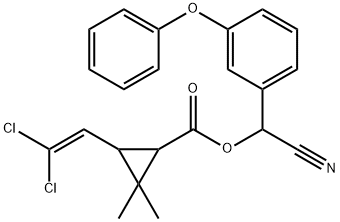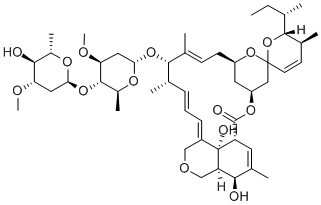Cypermethrin solution , analyticalstandard,10ug/ml,u=6%,inpetroleumether , 52315-07-8
Synonym(s):
Cypermethrin - CAS 52315-07-8 - Calbiochem
CAS NO.:52315-07-8
Empirical Formula: C22H19Cl2NO3
Molecular Weight: 416.3
MDL number: MFCD00055328
EINECS: 936-368-2
PRODUCT Properties
| Melting point: | 60-80°C |
| Boiling point: | 170-195°C |
| Density | 1.12 |
| vapor pressure | 2.5×10-7 Pa (20 °C) |
| refractive index | n20/D 1.57 |
| Flash point: | 100 °C |
| storage temp. | −20°C |
| solubility | Chloroform: Slightly Soluble,Methanol: Slightly Soluble |
| form | Viscous Liquid |
| color | Brown |
| Specific Gravity | 1.23 (20℃) |
| Water Solubility | insoluble |
| BRN | 8444118 |
| Stability: | Stable. Incompatible with bases, strong oxidizing agents. |
| EPA Substance Registry System | Beta Cypermethrin (52315-07-8) |
Description and Uses
Cypermethrin is a type II pyrethroid insecticide. It prolongs opening of sodium channels resulting in membrane depolarization and a conductance block of the insect nervous system, and point mutations in sodium channels induce cypermethrin-resistance in house flies, cockroaches, and mosquitos. Cypermethrin (1-1.5 mg) reduces survival of ticks (H. anatolicum) in vitro in a concentration-dependent manner. Topical administration of cypermethrin reduces the number of ticks on infested cattle. Cypermethrin (5 and 10 ppm) reduces survival of lice (D. ovis) in sheep fleece and prevents re-infestation in contact-challenged sheep for 7 and 19 weeks, respectively. It induces developmental neurotoxicities in zebrafish, increasing mortality and edema and inducing body-axis curvature when used at concentrations ranging from 50 to 200 μg/L. Cypermethrin (15 mg/kg twice weekly for 24 weeks) also induces Parkinson''s disease-like neurodegeneration in rats, decreasing locomotor activity, dopamine production, and the number of tyrosine hydroxylase positive (TH+) neurons in the substantia nigra.
Synthetic pyrethroid insecticide, usually exists as a mixture of cis and trans isomers. Ectoparasiticide
Safety
| Symbol(GHS) |    GHS06,GHS08,GHS09 |
| Signal word | Danger |
| Hazard statements | H301-H315-H317-H332-H335-H373-H410 |
| Precautionary statements | P273-P280-P301+P310-P302+P352-P304+P340+P312-P314 |
| Hazard Codes | Xn,N,F |
| Risk Statements | 20/22-37-50/53-43-37/38-22-36-20/21/22-11-52/53 |
| Safety Statements | 24-36/37/39-60-61-2-36-26-16-36/37 |
| RIDADR | UN 2810 6.1/PG 3 |
| WGK Germany | 3 |
| RTECS | GZ1250000 |
| HazardClass | 6.1(b) |
| PackingGroup | III |
| HS Code | 29269090 |
| Hazardous Substances Data | 52315-07-8(Hazardous Substances Data) |
| Toxicity | LD50 in 8 day old rats, adult male rats (mg/kg): 14.9, 250.0 orally (Cantalamessa) |


